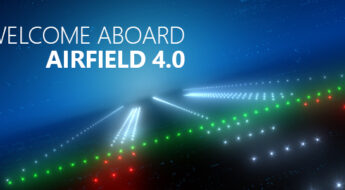
Follow the Greens at Heathrow – pilots love it, many know about it, but how is it really working and how was it developed and implemented? I asked Adam Spink, an active Heathrow Tower controller that I know from my work at EUROCONTROL some years ago, and more recently as my co-participant to the EUROCONTROL A-SMGCS Task Force.
Adam has a long experience as a controller, he started nearly 20 years ago. He started with NATS straight from High School, his only other job has been a paper round! Being English it’s understandable he is not much into football, instead he is a keen rugby fan, his home town of Plymouth being his favorite club.

Adam Spinks, ATCO at Heathrow
The maximum scheduled capacity is 84 movements per hour on two runways operated in single mode, one for departure, one for landing. However, we often exceed that, Adam explains. Hours with over 95 runway movements in an hour do occur. On top of that Heathrow have an extensive towing operation. For example, British Airways mainly operates from Terminal 5 in the far West of the airport. The British Airways maintenance areas are on the far East side; this means the towing movements can be very complex and add considerable workload to the controllers. In peak hours the controllers can be faced with an additional 20 ground movements. The work with Follow the Greens at Heathrow was initiated in the 1960s as an aid to aircraft navigating around the complex airport, especially at night.
Each Ground Movement Controller has a Lighting Panel Operator (LPO) next to them, in total around 20 LPOs are employed at Heathrow. The LPO manually switches the AGL to route the aircraft at night or when the visibility is less than 1100 meters. The main benefit is that basic instructions are understood more easily by those pilots who do not speak English as their first language. The other main benefit is the fact that there are two people solving problems, and cross-checking each other.
When it is daylight and the visibility is greater than 1100 meters, the LPO is still plugged in and actively monitoring the frequency. They aid with telephone communication with the airport operator (requesting FOD recovery, follow me support etc.) and also record on their HMI when the GMC controller gives a pushback clearance as a mitigation against the controller then giving a further, conflicting pushback or taxi clearance.
Very rarely the controller and the LPO misunderstand each other. The controller is ultimately responsible for safety, therefore they constantly double check the routes that have been set up. If the controller has a definite idea of a route, then they will coordinate with the LPO through the R/T that they transmit to the aircraft. For example, the controller might say to an aircraft: “Follow the greens, route via Charlie on to Alpha, hold short of Echo” And the LPO knows to route the aircraft Charlie – Echo. If the controller judges that defining a particular transition to Alpha is not important, they may say: “Follow the greens on to Alpha, hold short of Echo” and leave it up to the LPO to decide where the aircraft will join Alpha. If it is really quiet, they may just say: “Follow the greens, hold short of Echo” and leave the LPO to decide if the aircraft will even join Alpha.
When traffic complexity increases, the controller and LPO will be planning ahead by a few minutes, agreeing conditional scenarios such as: ‘If the BAW306 calls for taxi before the BAW123 reaches Echo, we’ll get it out first via Delta. If it doesn’t call in time, we’ll route BAW123 ahead of him through Echo’ etc.
There are three GMC positions, so there are defined handover points to permit the silent transfer of traffic from one to another. This means there is a basic given structure for the ground movements; however, there are no standard taxi routes at Heathrow.
Adam confirms that pilots are 100% positive. As mentioned above, it’s easier for non-English speaking crews to understand. Even English speaking crews like it as it takes up less capacity for the flight crews, especially following a 14-hour flight. It also provides another check against ATC or flight crew mistakes, if the verbal instructions and AGL route do not match then the crews should query this.
Finally, I asked Adam if there was something else he would like to add.
“It’s always a challenge working at Heathrow, working really hard to cope with an airport that is scheduled to over 99% of its capacity constantly brings new problems to overcome and new concepts to introduce. Every day is a new challenge”.
Thank you Adam, see you at the next A-SMGCS Task Force Meeting in April.
ADB SAFEGATE is a leading provider of intelligent solutions that deliver superior airport performance and operations, and jointly identify and solve bottlenecks. Our consultative approach enables airports to improve efficiency, enhance safety and environmental sustainability, as well as reduce operational costs. Our portfolio includes solutions and services that harmonize airport performance, tackling every aspect of traffic handling and guidance, from approach, runway and taxiway lighting, to tower-based traffic control systems and intelligent gate and docking automation. ADB SAFEGATE has 900+ employees in more than 20 countries and serves some 2,500+ airports in more than 175 countries















Excellent article and an informative walk-thru the system. Kudos to Adam.
Moe Vyas
http://www.aeroviacanada.com
http://www.aerowriter.com
The information is very good, and the assignment prompt that you used I think helped to show what you were trying to say. I appreciate your piece of work. Heathrow Airport Transfers